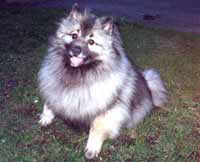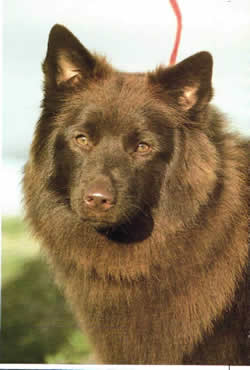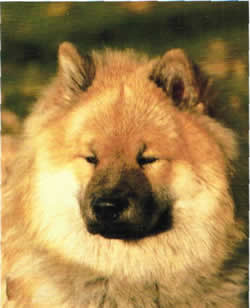|
We now have a Keeshond. It's a quite a bit larger than the lhasa apso. Like the golden, they're more sturdy than toy dogs and they seem to be as charming and sweet as the goldens. Our girl, though, is far tougher than any of our goldens.
She doesn't obey, no matter how hard you try, and if she's in the kitchen while we're eating, we have to watch her all the time. In addition you have to check carefully so she doesn't jump up and steals something from the table. She loves water more than any other dog we've ever had. Not for taking a bath in, necessarily, and not for drinking either, not primarily. She just loves to have a full water dish all to herself. To jealously guard. When she's had all she wants, she'll happily pour the rest out onto the floor. (No one else can have MY water!) She's really good at training people. At least she learned early on that if you sit down, people will think you're smart and cute. And if they do, you usually get a tasty snack. Walking on your hind legs is cute too, apparently, and then people appreciate you too. Even if you don't get anything to eat, you might escape some scolding. Keeshonden (that's the correct plural form of the name), used to be a fashionable dog among the Dutch aristocracy in the 18 century. Ordinary people, many living on riverboats, used the Keeshond as a guard dog. Kees is a nickname for someone named Cornelis/Cornelius. Hond means dog in Dutch. A man named Cornelius de Gyselaar was the leader of a political faction in a power struggle from around 1781. His group lost, Cornelis was executed, and after that owning a Keeshond was risky, and the aristocracy lost their interest in the breed. A very similar breed is the Wolfspitz, the largest of the German spitz dogs. In fact the German/Dutch spitz dog has a very long history. Archaeologists have found remains of similar types of dog from as early as Paleolithicum (5000 B C). The German spitzes are closely related
to the Dutch Keeshond. Some say that the Keeshond and the Wolfspitz
are identical. Apparently, that's not quite true, but they're still
quite similar. You might be familiar with the Pommeranian. That's
the British variety of the German Zwergspitz which translated means
Dwarf Spitz. They're all German spitzes but the ones that are normally
called that are the Kleinspitz (Small spitz), Mittelspitz (Medium
sized spitz) and the Gro■spitz (Large Spitz or Standard Spitz).
The names of the different German spitzes might be misleading, at least if you try to guess what size they are. The Wolfspitz is the largest. The Keeshond, which is not strictly speaking a German spitz, comes next, then the Gro■spitz (here's the confusing part, the "Large spitz" is actually more medium sized). The Mittelspitz is somewhat smaller, and the Kleinspitz smaller still. Smallest of all is the Pommeranian/Zwergspitz. From what I hear, they make good companions and guard dogs, because as most spitz dogs, they're quick to sound the alarm. And like most spitz dogs, they look very charming with their fluffy coats. I haven't actually owned a German spitz, though our Keeshond might have some German lines in her. She's certainly bigger than most ordinary Keeshonden. She has two Kees friends around town, both male, fortunately, since females tend to be hostile to each other. One of those Keeshonden has a black Kleinspitz baby brother. The Kleinspitz doesn't seem to care much for Keeshond bitches, but he was delighted to meet our lhasa apsos (the two black ones). Nice color, he seemed to be thinking. The Eurasian is a modern breed developed in the 1960s. Julius Wipfel of Weinheim, Germany, wished to develop a large and distinctive spitz type of dog with all the beautiful colors plus a mellower character for modern times. He crossed Chow Chow males with large German Wolfspitz bitches and called the new breed the "Wolf-chow." Later he crossed the Wolf-chow bitches with one Samoyed male, and that was the end of the crossbreeding. Good selection since that time has come to establish the breed, known since 1973 as the Eurasian, combining the best of the European and Asian spitz dogs to create a new one.
Although friendly and quiet with its family and other dogs in the pack, it can become quite fierce if necessary. It will not hesitate to attack someone threatening his people with harm, and is also quite capable of handling itself in a fight, even with larger dogs. Generally, they're very friendly and playful. They get along well with other dogs, of both sexes, and other pets - cats, rabbits and horses. These dogs live for a long time, usally 12 -15 years, or more. I'd really like to own one of these beautiful dogs one day. |

 The
Wolfspitz (means the same in German and English), is wolf colored
(Black/Grey). The Gro■spitz can be solid black, brown or white.
In the smaller sizes, there is more color variety.
The
Wolfspitz (means the same in German and English), is wolf colored
(Black/Grey). The Gro■spitz can be solid black, brown or white.
In the smaller sizes, there is more color variety.
